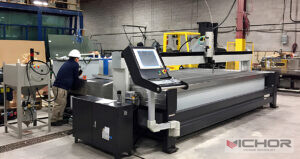
Water Jet Engraving Machine: Transforming Precision Engraving for Modern Industries
Imagine a tool that can carve intricate designs into the toughest materials with the gentle force of water—no heat, no dust, and no compromises on precision. This is the reality of the water jet engraving machine, a technology that has redefined engraving across countless sectors. From industrial manufacturing to artistic creations, this machine offers unparalleled versatility and accuracy. In this article, we’ll dive deep into how a water jet engraving machine works, its applications, benefits, types, and maintenance tips. Whether you’re a business owner, engineer, or hobbyist, understanding this equipment can unlock new possibilities for your projects.
How Does a Water Jet Engraving Machine Work?
A water jet engraving machine operates on a straightforward yet powerful principle: using high-pressure water, often mixed with abrasive materials, to cut or engrave surfaces. The process begins with a pump that pressurizes water to extreme levels, typically between 50,000 to 90,000 psi. This pressurized water is then forced through a small nozzle, creating a focused stream that moves at speeds exceeding twice the speed of sound. When abrasives like garnet are added, the stream becomes capable of etching or cutting through hard materials such as metal, stone, or glass.
The key components include the high-pressure pump, the abrasive delivery system, and a CNC (Computer Numerical Control) unit that guides the nozzle along predefined paths. This automation ensures consistent results, allowing for complex patterns and fine details. One of the standout features of a water jet engraving machine is its cold-cutting process, which eliminates heat-affected zones. This makes it ideal for materials sensitive to temperature changes, preserving their structural integrity. Overall, the technology combines fluid dynamics and precision engineering to deliver clean, burr-free engravings.
Applications of Water Jet Engraving Machines
The versatility of a water jet engraving machine makes it a go-to solution in diverse fields. In industrial settings, it’s used for marking parts with serial numbers, logos, or barcodes on components like engine blocks and aerospace fittings. The automotive and aerospace industries rely on it for its ability to handle robust materials without inducing stress or micro-cracks.
In the art and design world, artists use water jet engraving machines to create detailed sculptures, signage, and decorative elements on materials such as marble, acrylic, and wood. Its precision allows for reproducing intricate designs that would be challenging with traditional tools. Additionally, the architecture and construction sectors employ these machines for engraving tiles, stones, and glass panels, adding custom patterns to buildings and interiors.
Another growing application is in the medical field, where a water jet engraving machine is used to mark surgical instruments and implants with identification codes. This ensures traceability and compliance with regulatory standards. Even in education and research, these machines serve as valuable tools for prototyping and experimental projects, demonstrating their broad utility.
Advantages of Using a Water Jet Engraving Machine
One of the primary benefits of a water jet engraving machine is its material versatility. Unlike laser or plasma cutters, it can process a wide range of materials, including metals, composites, ceramics, and plastics, without altering their properties. The cold-cutting nature prevents thermal distortion, making it suitable for heat-sensitive substrates like tempered glass or certain alloys.
Another advantage is the environmental friendliness of the process. A water jet engraving machine typically uses water and natural abrasives, reducing the emission of harmful fumes or waste compared to chemical etching methods. This aligns with sustainable practices, as the water can often be recycled, and the abrasives are non-toxic.
Precision and flexibility are also hallmarks of this technology. With CNC integration, a water jet engraving machine can achieve tolerances as tight as ±0.1 mm, enabling high-repeatability for mass production. Operators can easily adjust settings for different depths and styles, from shallow engravings to deep cuts. Moreover, the lack of tool wear minimizes downtime and maintenance costs, enhancing overall efficiency.
Types of Water Jet Engraving Systems
Water jet engraving machines come in various configurations to suit different needs. The most common types include pure water jet systems and abrasive water jet systems. Pure water jet engraving machines use only pressurized water and are ideal for softer materials like foam, rubber, or food products. They excel in applications requiring fine, delicate engravings without the risk of contamination.
Abrasive water jet systems, on the other hand, incorporate garnet or other abrasives into the stream, enabling them to handle harder materials. These are further categorized into 2D and 3D systems. A 2D water jet engraving machine operates on a flat plane, perfect for sheet materials and simple designs, while a 3D version allows for multi-axis movement, engraving on curved or complex surfaces.
Portable and stationary models are also available. Portable water jet engraving machines offer mobility for on-site jobs, such as in construction or repair work, whereas stationary units provide higher stability for industrial production lines. Understanding these types helps users select the right machine based on their material requirements, budget, and workspace constraints.
Maintenance and Operational Guidelines
Proper maintenance is crucial for maximizing the lifespan and performance of a water jet engraving machine. Regular checks should include inspecting the high-pressure pump for leaks, cleaning the nozzles to prevent clogging, and replacing worn abrasives. It’s recommended to use filtered water to minimize impurities that could damage internal components.
Operators should follow safety protocols, such as wearing protective gear and ensuring the machine is grounded to prevent electrical hazards. Calibrating the CNC system periodically ensures accuracy, and software updates can enhance functionality. For abrasive systems, monitoring the abrasive hopper and delivery lines helps maintain consistent flow rates.
Routine servicing, such as checking seals and valves, can prevent costly breakdowns. Many manufacturers provide maintenance schedules, but users can also keep logs of usage to anticipate part replacements. By adhering to these guidelines, a water jet engraving machine can deliver reliable performance for years, reducing downtime and operational costs.
Frequently Asked Questions (FAQ)
Q1: What materials can a water jet engraving machine process?
A1: A water jet engraving machine can handle a wide variety of materials, including metals (like steel and aluminum), stones (such as granite and marble), glass, ceramics, plastics, and composites. Its versatility stems from the adjustable pressure and abrasive options, making it suitable for both soft and hard substrates.
Q2: How accurate is a water jet engraving machine compared to other methods?
A2: A water jet engraving machine typically offers high accuracy, with tolerances as precise as ±0.1 mm. This rivals or exceeds methods like laser engraving, especially for thick or reflective materials. The cold-cutting process also avoids heat-related distortions, ensuring cleaner edges and finer details.
Q3: Is a water jet engraving machine safe to use in indoor environments?
A3: Yes, a water jet engraving machine is generally safe for indoor use when proper ventilation and safety measures are in place. It produces minimal dust and no toxic fumes, but it can be noisy, so hearing protection is advised. Regular maintenance and water containment systems help manage splashes and debris.
Q4: What is the average cost of operating a water jet engraving machine?
A4: Operating costs for a water jet engraving machine vary based on factors like energy consumption, abrasive usage, and maintenance. On average, abrasive costs can range from $0.50 to $2 per hour, while electricity and water expenses are relatively low. Initial investment includes the machine price, which starts from a few thousand dollars for basic models.
Q5: Can a water jet engraving machine be used for 3D engraving?
A5: Absolutely. With multi-axis CNC capabilities, a water jet engraving machine can perform 3D engraving on curved or irregular surfaces. This is ideal for applications like sculptural art or complex industrial parts, allowing for depth variations and intricate patterns that flat engraving cannot achieve.
In conclusion, the water jet engraving machine stands as a transformative tool in modern engraving, offering precision, versatility, and efficiency. By understanding its workings, applications, and care, users can harness its full potential for innovative projects. If you’re considering integrating this technology, assess your specific needs to choose the right system for lasting benefits.
continue reading



